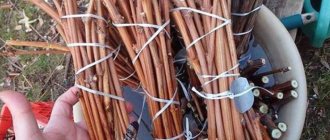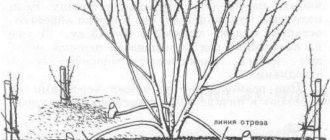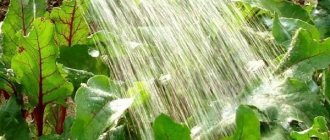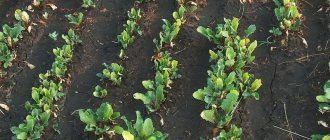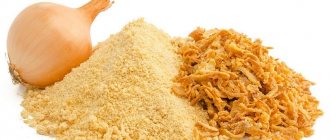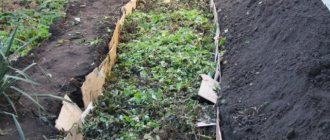The climate characteristics of most regions guarantee a high yield of onions only when the crop is grown in a two-year cycle - through seeding. In the first year, small seed bulbs are obtained from the sown nigella, which are planted in the ground in the second year to obtain marketable onions.
It is not always possible to plant seeds for the winter - there is a need to save a supply of planting material until spring arrives.
General rules for storing seedlings before planting
For storage use containers with good ventilation . The seeds are stacked in several layers, but not higher than 30 cm. Self-harvesting is carried out at the end of August.
Whole bulbs are sorted without traces of rotting, dried in the fresh air in the shade or in a warm place at a temperature of +25...30°C.
It will be possible to keep the seedlings intact until planting only in a room where the temperature and humidity levels are maintained.
Diseases of sowing due to improper storage
The most dangerous disease that can affect onions during storage is neck rot. At first it is invisible, then the neck becomes soft to the touch. Over time, the disease covers the entire bulb. Gray mold appears on top of it, and inside it becomes watery and pinkish. If healthy bulbs become infected in storage from sick ones, then rot may begin not from the neck, but from the sides or bottom.
White rot is another nuisance that can happen to seedlings during storage. A white cotton-like coating appears on the bulbs, and then small black inclusions. The onion rots inside.
Smut infestation appears as dry rot. With bacterial rot, the outside of the bulb dries out and the inside turns into an unpleasant-smelling slimy mass. The most common pest is the onion mite. It penetrates the bulbs through the bottom, it becomes soft and rots.
Before storing vegetables, you need to disinfect the room in advance, and during storage, provide them with a stable temperature regime and good ventilation. Temperature fluctuations should not be allowed, otherwise the seedlings will sweat and rot.
Drawers and shelves must have gaps for air access. It is better if they are made of wooden slats. Additionally, you can sprinkle the bulbs with dry chalk at the rate of 100 g per 5 kg of raw materials. If the seeds become wet during storage, they must be dried. Bulbs affected by diseases or pests are removed and burned, and sprouted ones are used for forcing into greens.
Choosing a storage location
To avoid early germination, onion sets are stored at a temperature of +2...3°C with a humidity level not exceeding 65%. Such conditions can be created in the basement or cellar. If the temperature is too low, the seeds will lose their viability.
Previously, onions were stored braided. During Soviet times, methods were improved: stockings, wicker baskets, bags made of natural material or boxes with holes were used for storage.
Plastic and wooden boxes
For long-term storage, choose small boxes. When using plastic boxes, they should have holes to allow air to flow evenly. The bulbs are stacked in several layers. This storage method is convenient when there is not enough space in the room.
Canvas bags
Choose small bags with a capacity of bulbs no more than 20 cm in height. They are stored filled, hanging from the ceiling or placed on stands, since contact with the floor or walls causes the accumulation of moisture and rapid rotting of the planting material.
Egg containers
If there is a lack of storage containers, egg containers are used. The trays are moved to racks or special stands and the onions are placed separately in each cell.
Preparation for storage
Onion sets must be stored in a well-ventilated place with a constant temperature. Otherwise, it may freeze or overheat, and become unsuitable for spring planting.
Onion sets are smaller in size compared to regular onions.
To properly preserve the seedlings, you need to follow the subtleties of its preparation:
- Pay special attention to the choice of seed. Onion sets should have greater density and a natural shade. It is important that the surface of the set is not deformed.
- Make sure there is no smell of rot in the bulbs. Why onions rot during storage is described in this article.
- Select the seeds in sunlight to thoroughly inspect all the raw materials. One spoiled onion can cause an entire container of sets to rot.
- From each bulb you need to clear the remaining soil.
- Dry the sets. Its roots should be perfectly dry and straightened. New shoots should not appear on them.
- To dry the onions, place them in a small room with optimal humidity and air circulation. The temperature during drying should be no more than 32 degrees. The onion is kept in such conditions for 7 days.
- After drying, you need to warm the sets at 40 degrees for 24 hours.
- You can place the onion in a small stocking and hang it out to dry.
Drying bulbs in stockings
During the drying process, you can keep the sets in a bag, basket or plastic container. Clean air must enter the container.
Optimal conditions
To create optimal conditions, pay attention to temperature, humidity and ventilation in the room. The most difficult task is ensuring a constant level of air humidity. When the temperature is high, the onion sprouts and putrefactive diseases develop; when the temperature is low, it dries out. Ideal figures are 50-65%.
To protect the crop from drying out, it is sprinkled with the remaining onion peels. Reduce indoor humidity by placing a container with lime, wood shavings or ash.
The room in which the onions are stored is ventilated. The boxes with the harvest are placed so that there are no obstacles to the free movement of air.
If it starts to rot
To prevent onion sets from starting to rot, you need to follow all storage recommendations:
- Correct preparation process.
- Specified room temperature.
- Humidity percentage.
- Regularity of ventilation.
- The right storage container.
If the set suddenly begins to rot, it can still be saved. Separate rotten or infected husks from it. If the set has been severely affected by rotting, you can completely remove all the skin from it. During storage, the husk will again cover the onion and it will be possible to plant it in the spring.
In winter, you should definitely look at the sets. If it is clear that the onions are rotting, they are removed from the main raw material.
Varieties that do not have high shelf life include Stardust onions, which you can read about here.
Check the husk by touch. If it becomes wet, the onion must be dried.
How to prepare sets for long-term storage
To keep onions for a long time, follow these rules:
- The sets are sorted and sprouted specimens are removed. The bulbs should be whole, with a dry tail.
- For planting, select seeds ranging in size from 1 to 2.5 cm.
- After purchase, the seed is dried at a temperature of +30°C for two days. This is done outdoors in the shade, or indoors in rainy weather. In a private house or apartment, onions are laid out next to heating devices, where the air temperature is +25...30°C.
- If there are traces of rotting on the surface, peel the onion. If it is necessary to completely remove the husk, the planting material is dried again. Then the top layer of the onion will turn into a covering scale.
- It is recommended to prepare in advance the room where the seeds will be stored. The underground is ventilated at the end of summer or early autumn. Equipment located in the cellar is dried in the fresh air. If mold is present, the damaged areas are cleaned. If there are rotten boards, they are replaced.
Advice from experienced summer residents
Owners of summer cottages for planting onions, in addition to home-produced sets, often use purchased ones - from online stores, retail chains, purchased from grandmothers at the market. In autumn, the choice of planting material is greater and its cost is lower.
How to save purchased seedlings before planting in the spring
Since sets are most often purchased at the end of winter, it is not known how they were kept until this time. To avoid bolting of planted onions, seeds should be stored only in a warm way.
- An obligatory point is that after purchasing the seed, it must be warmed/dried and stored until planting at a temperature of +20...+22 °C.
- On the eve of planting, the seeds are heated for 8 hours at a temperature of 40-44 °C to awaken dormant buds.
This heat treatment will prevent bolting.
The sevok is a little rotten - what should I do?
During an inspection of the planting material, it was discovered that the seedlings were damp and began to rot. The situation can be corrected - just select the rotten bulbs and remove the rot-damaged layer from them (down to healthy scales). If necessary, wipe the bulbs with a dry soft cloth.
After some time, new protective scales are formed on the surface of the set - already healthy.
Experienced summer residents have their own secrets; they willingly share the intricacies of storing seed sets. Correct selection of varieties, timely harvesting of bulbs from the garden and high-quality drying of planting material are only half of the necessary conditions. The second half is choosing a storage method that corresponds to real possibilities and paying close attention to the seedlings all winter until spring.
Storage methods
Depending on the variety, onions are stored warm, cold or combined.
Cold
This method involves placing the seed in a refrigerator, underground or cellar, where the temperature is kept within -3...-1°C. This will protect the bulbs from sprouting and drying out. Two weeks before planting, the seeds are heated to enhance the growing season.
Important! Under no circumstances should you use a balcony to store seedlings in winter. Constant changes in temperature will lead to rotting or death of planting material.
Warm
This storage method is suitable for those who plan to keep onions for sowing in the apartment. To do this, choose a dry, dark place where the air temperature does not exceed +17…23°C. Seeds are placed in boxes or bags.
The temperature and humidity in the apartment often change, so planting material is periodically poured out and checked for early germination and rot.
Combined
This method involves changing the temperature during storage. Keep the bulbs in a warm place until the first frost. With the beginning of winter, they are placed where the temperature does not drop below zero.
In spring, the seed is placed in a warm room heated to +25°C for 5 days. After this time, the temperature is reduced to +22°C and left until sowing into the ground.
How to properly store onion sets at home
Seeds grown for planting can be stored in different ways. Let's look at the possible options in more detail.
Warm way
With this storage method, onions are kept in a pantry, room, mezzanine or other place with appropriate conditions:
- The temperature must be maintained at +18…+25°C.
- To prevent onions from germinating, humidity should not exceed 50 to 70%.
- It is necessary to ensure good ventilation; therefore, containers for wintering onion sets need to be loose. Nets, stockings, boxes, boxes with cells or lattice holes are suitable for this purpose.
- The layer of onions in the container should not exceed 20 cm.
- Changes in humidity and temperature should be avoided. These indicators must be stable, which will ensure quality storage.
Important! You cannot use bags to store onion sets - they are airtight and can cause rapid rotting.
Cold
If you have a basement or shed, cold storage is a good option.
The savings location must also meet a number of requirements:
- Constant temperature is maintained at a level from –3°C to 0°C.
- Humidity does not exceed 80%;
- Just as with warm storage, you need to avoid fluctuations in temperature and humidity. Such jumps not only affect the quality of planting material, but can also provoke onions to shoot in the future.
Another option for the cold storage method is the refrigerator. If you have a large refrigerator, this option will be an alternative to the cellar. Onions should be packed in a linen bag, mesh or nylon tights and placed on the coldest shelf of the refrigerator. With this storage method, maintaining a constant temperature and humidity will not be difficult, and bulb losses will be minimal. An interesting method for wintering planting onions is the use of sawdust.
This method consists of several stages:
- Place a layer of sawdust approximately 10 cm thick at the bottom of the bucket.
- Pour the bulbs onto the sawdust, but not to the very top - leave about 15 cm.
- Fill the bucket with sawdust, leaving about 5 cm to the edge of the bucket, and close the lid. This creates an air gap above the sawdust.
- Dig a hole and place a bucket of onions in it.
- Cover with soil on top. The layer of soil above the bucket must be at least 20 cm.
- In the spring, after the soil has thawed, the container must be removed.
The advantage of this method is that the bulbs remain juicy and fresh.
Important! When using the cold storage method, onions must be planted no later than 10–12 days after extraction, since a change in temperature will cause them to spoil.
Combined method of storage of sets
This option combines the above methods. Many gardeners preserve onion sets by alternating temperatures.
But this method does not imply sudden temperature changes, but systematic changes corresponding to the biological rhythms of the plant:
- after drying, the onion sets are kept until the first frost at a temperature of +18...+20°C;
- when frost sets in, the seed is sent to a room with a temperature of –3…–1°C;
- In the spring, the onions are again placed in a warm place (about +24°C).
With any of the above methods, the seedlings need to be warmed up before planting. The heating temperature is about +35°C, and the duration is 3–5 days. This will stimulate the beginning of growth and help avoid the occurrence of diseases.
What to do if the seedlings begin to rot
To avoid the problem of onion rotting, it is important to properly prepare the planting material and provide suitable storage conditions . But even if all the rules are followed, the source of spoilage can be fungal diseases, stem nematodes, and onion root mites.
When the first signs of rot or spoilage appear, action is taken immediately. To begin with, pour all the planting material onto a flat surface and sort it, discarding all damaged bulbs. If traces of rot appear on the surface or the husks become wet, peel them and dry the onions in a warm place until a new husk forms.
What and how affects the winter storage of onion sets
Logically, the optimal temperature for storing sets will be just above 0 °C, when the bulb is at rest. However, a biennial plant at this temperature goes through the stage of natural vernalization. Planted in the spring, such seeds are used for shoots and color, and not for setting large turnips.
Keeping small seed bulbs warm prevents vernalization of the seed material.
Problems of a different kind arise - in the heat, the bulbs actively breathe and dry out, and by the time of planting they lose the ability to germinate. The predisposition to long-term storage of sets during the winter is influenced by many factors.
- Onion variety.
Initially, only zoned varieties with good keeping quality should be left for winter storage. A characteristic feature of a shelf-stable variety is the golden color of the outer scales; red and white varieties of onions are not stored for a long time.
- Correctly chosen time for harvesting seedlings from the garden bed.
If there is a delay in harvesting onions, the keeping quality of the crop decreases sharply - the plant enters the 2nd stage of the 2-year cycle: it grows roots and prepares for wintering in the ground. The biological rhythm is disrupted after untimely harvesting - keeping quality worsens.
- Storage of unsorted seed material of onion sets.
This leads to the fact that against the general background, the drying out of the smallest onions is hardly noticeable, while large ones (1-3 cm in diameter) are stored well under equal conditions. In any case, even if all precautions are taken, onion seeds stored for winter must be checked 1-2 times a month in order to identify the problem in time - the appearance of rotten onions, traces of fungus or mold.
Shelf life
The shelf life of onions depends on the dormant stage of certain varieties and the sufficient content of essential oils and dry substances. Sets of late and spicy varieties are suitable for long-term storage. Early sweet ones, on the contrary, are not stored for more than two months - they begin to deteriorate and sprout.
White onions with yellow skins are the most popular and spicy. They are stored the longest if favorable conditions are created before sowing.
White onion seeds can be stored for up to six months, but are more demanding on indoor conditions. At high humidity, this variety begins to rot.
Red onions do not last long: under normal conditions - no more than two months.
Storage conditions
To prevent onions from spoiling at home during the winter, you need to take care of several factors:
- about the temperature - it should be about 20-25 ° C, although if necessary, you can keep the onions in the cold;
- about air humidity - it is necessary to maintain it at the level of 50-75%.
When planting planting material, you need to take into account that at home, some of the bulbs will in any case deteriorate during the winter. The heads are harvested with a reserve so that inevitable losses do not lead to a decrease in yield in the next season.
Attention! Storing the set in excessive dryness causes a loss of its viability, and with increased humidity, the onion begins to rot.
Adviсe
A paper bag will help extend the shelf life. The bulbs are placed in a container, having previously made numerous holes with a hole punch. In such a package, the shelf life will increase to two months.
To keep the sets longer, it is recommended to cut off the top about 5 cm.
Rotating crops on the site will help prevent pest infestation. Onions are planted the next year after early potatoes, cucumbers or cabbage. The bed is reused for onions only after 3 years.
Which varieties store best over the winter?
As a rule, golden varieties of seeded onions are stored the longest, for example:
- Stuttgarter Riesen;
- Sturon, Universo F1;
- Troy;
- Centurion;
- Hercules;
- Setton.
Among these varieties there are both mid-late and early ripening varieties. From red varieties you can choose :
- Red Baron;
- Red Carmen;
- Danilovsky 301.
All these varieties tolerate winter storage well, are resistant to rot and disease, and tolerate dry weather well.
White onions should not be left for storage all winter , just like many varieties of red ones. These species most often begin to rot or sprout before it is time to plant the bulbs in the soil.
Reviews
Experienced gardeners share secrets on how to preserve onions until spring.
Tatyana, Rostov-on-Don: “We dug up the onions last week and put them under a shed to dry. Today I peeled the husk down to the first coat and put it in wooden boxes. In a week I plan to put it underground and leave it until spring. The temperature there is from 0 to +3°C, it is stored perfectly every year.”
Natalya, Volgograd: “We are used to storing onions in the apartment. I usually make holes in the box and put the seeds there. Then I put it in a dark place and take it out 2-3 times throughout the winter to check the condition of the sets. In winter, the apartment is dry, so the onions are stored until spring.”
Alena, Izhevsk: “I used to store onion sets in the refrigerator. But often at a temperature of 0...+4°C and high humidity, onions germinate. That’s why lately we put the seeds in the basement or bury them in the ground.”
Storage of planting material
In order for large bulbs to grow, and not arrows, you need to properly store the sets before planting:
- The purchased onions are sorted. Damaged and rotten sets are discarded, and good ones are transferred to a cardboard box.
- The bulbs are dried at a temperature of about 22 degrees Celsius for several days. During drying, do not cover the box with a lid or film. There must be air flow.
- The box with onions is transferred to a dry, dark place. Store at temperatures from 17 to 25 degrees. Periodically stir and sort the onions.
- A week before planting in open ground, the onion sets are heated to +35 near the radiator: it will give a decent harvest and will not shoot out.
Storage Features
In most cases, if storage was carried out correctly, onions will safely last until next spring. However, the following factors may affect the shelf life:
- variety of sevka. White and red bulbs germinate much faster than yellow ones;
- time to dig up bulbs. If the sets are dug up earlier or later than expected, the onions quickly rot.
Otherwise, storing onions is as easy as shelling pears: just dig it up, prepare it and put it in a specially designated place until it warms up.
How to keep green onions fresh in the refrigerator for a long time
Any dish will look more appetizing if it is sprinkled with herbs on top. I have already told you how to freeze dill, tomatoes, bell peppers and green peas for the winter. And green onions can also be frozen, and even after freezing they will look as beautiful in the finished dish as fresh ones.
To preserve green feathers for a long time, it is best to freeze them. To do this, the feathers must first be processed, their roots, wilted and dried tips removed, washed and dried on a towel. Well-dried feathers are cut into small (5-7 mm) rings, so that they can then be conveniently added to salads and soups.
The chopped feathers are transferred to dry containers and tightly closed with a lid. Greens have a specific smell, and to prevent other foods in the freezer from becoming saturated with this smell, the container should be sealed tightly.
Green feathers can also be frozen in plastic bags, having previously displaced all the air from it.
Frozen onions can be removed from the freezer at any time. Pre-dried onions do not freeze in one lump, so you can take the required amount and put the rest in the container back in the freezer.
If you want to keep green onions fresh for several days, after treating them to remove roots and wilted tips, place them in a jar of water. The water must be changed at least once a day. And it must be used in food no later than 5 days.
In conclusion, there are a few more useful tips - life hacks on how best to preserve this useful and irreplaceable vegetable so that it does not quickly deteriorate or rot.
- Sprinkle with crushed chalk, it will absorb excess moisture. To do this, take 1-2 handfuls of chalk per 1 kg of vegetables.
- The lower part (bottom) is coated with clay and dried before storage, or burned with fire.
- Place a container of husks, chalk, sawdust in the room, that is, something that absorbs moisture well.
The first sign of rot will be flies flying in the room. This is a signal that the onions urgently need to be sorted out and rotten specimens removed.
Good luck to you!
Choosing an onion variety for future sowing
The future harvest largely depends on the variety of onion sets chosen for planting. When choosing a variety, you need to pay attention to the following criteria:
- ripening time;
- variety yield;
- resistance to vegetable diseases.
Onion set "Stuttgarter Riesen"
This variety is recommended to be planted in northern regions with short summers, as it is an early ripening variety. Round, flattened bulbs of regular shape are characterized by a rather small size.
After ripening, the bulbs gain a mass of about 300 grams. The variety is perfectly stored and used in the preparation of salads and preparations. Agrotechnical care includes regular watering, loosening the soil and removing weeds.
Onion set "Sturon"
An early variety, the full ripening of which occurs 10–15 days earlier than other varieties ripen.
The weight of ripened bulbs varies from 100 to 150 g. This variety is valued for its long storage and high resistance to diseases affecting onion crops.
Onion set "Centurion"
A new variety of onion, with elongated bulbs, is characterized by large fruits with a pronounced burning taste, which goes perfectly with meat dishes and bland salads. The mass of the bulb reaches 180–200 g.
Excellent adaptability to harsh climatic conditions and high resistance to diseases became the criteria due to which gardeners fell in love with this variety.
Among the mid-early and late varieties, the following varieties are especially popular: “Hercules”, “Red Baron”, “Rada”, “Shakespeare”, “Bamberger” and “Senshui Ellow”.
Which onion sets are best to plant for storage?
To successfully preserve onion sets before planting, you must first pay attention to the choice of variety. Spicy varieties of the crop survive winter best at home. They have dense pulp, numerous external scales and contain a large amount of essential oils.
Hot varieties of onion sets have a shelf life of up to 7-8 months
Semi-sharp onions are stored worse at home and require more attention from the gardener. But at the same time, such varieties bring a very abundant harvest. Sweet varieties are rarely left for sowing, although sprouted onions have the most pleasant taste.
When choosing planting material, you need to pay attention not only to the variety, but also to the dimensions:
- The best keeping quality is demonstrated by fractions 14-21 mm in diameter. This set does not bolt and tolerates winter well at home.
- Planting material up to 8-14 mm in diameter germinates quite well, but usually takes 2-3 weeks longer to mature.
- Onions with a width of more than 21 mm may produce arrows during germination. But if you remove flower stalks in time, the crop will ripen earlier than when planting fractions of smaller sizes.
When selecting seedlings for winter storage at home, it is necessary to ensure that the material is of high quality, regardless of the variety and size. The onion should be healthy, with uniformly colored scales and a dry neck, without mold or putrefactive odor. Specimens with seedlings or root buds in the lower part should not be taken for sowing.





